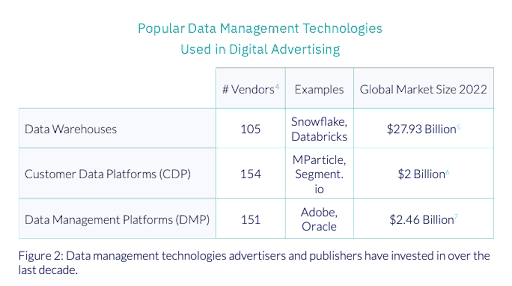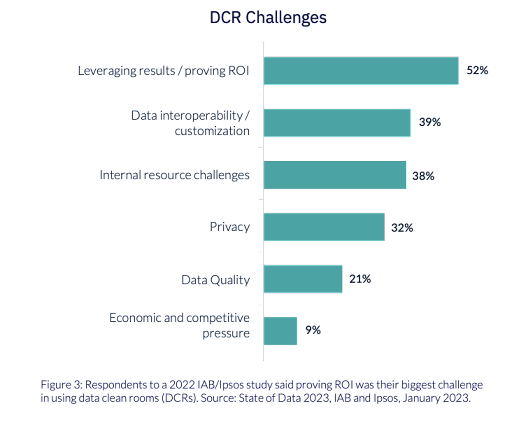
Data collaboration is crucial for media companies to adapt and compete in a privacy-focused and technologically complex environment.
Staying ahead of the curve has become more challenging than ever in the ad tech industry. The traditional ad industry was already grappling with losing cookies and other identifiers, striving to compete with the formidable triopoly of Google, Facebook, and Amazon. As it was gearing up for this transformative shift, the digital advertising landscape experienced a significant downturn.
The COVID-19 pandemic accelerated changes in consumer behavior, causing the market to soften as pandemic restrictions eased. The growth in digital ad spend, which had been on a double-digit trajectory, slowed to just 8.6% in 2022, leaving media giants and digital platforms with no choice but to reevaluate their strategies.
The pandemic forced major players like Disney, Roku, Spotify, and Warner Bros. Discovery to make difficult decisions, including staff layoffs. The year 2023 brought challenges, with industry titans like Google, Microsoft, Meta, and Amazon handing out pink slips to 50,000 employees in January alone. While advertisers are still spending, the expenditure isn’t as high as previously predicted, and scrutiny over ad investments has intensified.
Despite these challenges, experts expect the ad market to reach a record high of $326 billion in 2023, thanks to the explosive growth of streaming and short-form video ads on platforms like TikTok. Optable’s Data Collaboration for Media Owners latest white paper predicts growth in e-commerce, travel, and entertainment advertising, presenting opportunities amidst uncertainty.
Adapting to Change
Several key strategies are emerging as the advertising industry navigates these turbulent waters. Media companies focus on scaling programmatic and data-driven advertiser engagements to capture more revenue share from the advertising triopoly. Simultaneously, they enhance traditionally non-data-driven aspects of their ad businesses, such as sponsorships, to remain competitive and appeal to advertising partners.
However, the successful execution of these strategies requires the right technology. Over the past decade, the industry has witnessed a proliferation of adtech and data management solutions. Media executives now question whether these investments have met their expectations and can adapt to the industry’s constant churn. New consumer privacy regulations further complicate matters, limiting digital identifiers and forcing marketers to rethink how they use data for digital advertising.
The Data Management Landscape
Before delving into the intricacies of data collaboration, it’s essential to understand the data management technologies adopted by media companies:
- Data Warehouses: Companies like Snowflake and Databricks have taken the lead, with a market size of $27.93 billion in 2022.
- Customer Data Platforms (CDP): MParticle and Segment.io are notable players, with a market size of $2 billion in 2022.
- Data Management Platforms (DMP): Adobe and Oracle have made their mark, with a market size of $2.46 billion in 2022.
These technologies have enabled media companies to leverage their first-party audience data effectively. However, they face challenges in securing data collaboration with their advertising partners
The Need for Secure Data Collaboration
Digital marketers, who rely heavily on data for planning and executing ad campaigns, are increasingly concerned about data privacy, particularly in light of regulations like GDPR. A survey by GetApp revealed that 82% of marketers are worried about data privacy in their activities. Consequently, digital marketers are eager to collaborate directly with media partners in a secure environment to enhance campaign targeting and measurement.
Data clean rooms have emerged as a solution to this need for secure data collaboration. These rooms allow companies to share and analyze first-party consumer data while safeguarding individual identities. Giants like Google, Facebook, and Amazon have already adopted this approach with their advertisers, paving the way for private data clean rooms to gain momentum.
Benefits of Data Collaboration for Media Owners
Media companies that can accommodate advertisers’ demands for private data collaboration stand to gain a significant market advantage. Data collaboration can boost revenues by attracting new advertisers, securing larger commitments from agencies and advertisers, and commanding premiums on ad products that leverage shared data.
However, media companies face a dilemma: scaling data collaboration initiatives while simplifying their technology stacks and reducing costs. In a rapidly growing economy, complexity often takes a back seat to immediate growth opportunities. However, when the focus shifts to efficient growth and profitability with limited resources, complexity becomes costly and hinders operations and innovation.
Successful publishers must enhance their standard products and create differentiated offerings to compete with dominant platforms like Google and Amazon. Achieving this requires data collaboration solutions that can harness various types of data, seamlessly integrate with existing tech stacks, and offer ease of use.
Challenges in Data Collaboration
Implementing data collaboration, especially when relying on a mix of data management technologies, introduces several challenges:
Lack of Interoperability: Data clean room solutions often lack true interoperability, requiring collaborators to use the same system. This becomes a barrier when key advertising partners use different systems. Some media owners resort to multiple solutions, which can be costly and time-consuming.
Fragmented Data: Data fragmentation poses a challenge in combining audience data and advertising campaign data to provide holistic insights. The multitude of technologies available for this purpose may not be optimized for advertising use cases, leading to complexity and delays in responding to advertiser requests.
Not Intuitive for Business Users: Bridging the gap between technology and business teams in ad-supported media organizations is challenging. Ad Sales and AdOps teams lack the expertise to generate custom queries, relying on data scientists from other departments. This results in time-consuming back-and-forth interactions and lost revenue opportunities.
Gaps in Data Privacy and Security: The complexity of data collaboration involving multiple systems, users, and regions makes it difficult to maintain robust privacy and security standards. Privacy Enhancing Technologies (PETs) have progressed, but the plethora of options and regional considerations add to the complexity.
The Path Forward
To thrive in this ever-changing landscape, media companies need holistic solutions that can harness the power of data, integrate seamlessly with existing tech stacks, and cater to business users. The industry is realizing that the key to success lies in simplifying complexity and reducing friction in data collaboration.
Cloud-based data collaboration applications offer a promising path forward. These applications facilitate interoperability, ease of use for business users, and enhanced privacy and security. They enable media companies to streamline their operations, reduce technology costs, and innovate more efficiently.
As data collaboration continues to evolve, proving value remains a top challenge. Media owners must demonstrate the ROI of their data collaboration efforts. While challenges persist, the potential for increased revenue, reduced technology costs, and improved operational efficiency positions data collaboration as a crucial component of the future of advertising.


